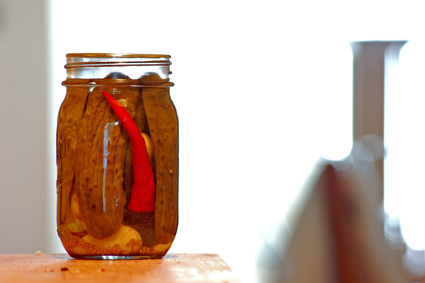We've been eating a lot of Thai food lately, due in part to two (relatively) new nigh-essential kitchen items I wish I'd had long ago: Real Thai: The Best of Thailand's Regional Cooking by Nancie McDermott and a real Thai mortar and pestle. It's an eight-inch-wide, fifteen-pound monster, carved from solid granite:

Here it's filled with a green curry paste, which took less time and effort than in either of my other two mortars.1 Not that they don't have their uses, but big batches of curry paste aren't their forte. The food processor's not ideal, either; it's okay, but the texture usually ends up chunkier than I'd like.
Besides, this beast really gives you the feeling that you're making something through honest work. I'd picked it up from ImportFood.com, a specialty Thai mail-order website, which seemed to offer the best price, as well as the best shipping rate. As for the shipping, I now know why: they managed to fit it - just barely - inside a US Postal Service Priority Mail Flat Rate box. Judging by the beating that box had taken by the time it arrived on my doorstep, it stretched the capacity of that box to the limit - but at least the mortar's nigh indestructible.
I'm almost convinced I could pulverize gravel in it, should the need ever arise.
Now, don't be fooled by those little cans of red, green, yellow, mussaman, etc. curries in the corner Asian grocery. You know, the ones that look like pet food, with the smiling image of an elderly Thai grandmother on the wrapper? They're not bad, especially if you're pressed for time, but the flavor's essentially one-dimensional compared to the real thing - made from high-quality, fresh ingredients - and they're loaded with salt. You'll probably be adding a fair bit of salt to the rest of the recipe, between the fish sauce, soy sauce, shrimp paste, or whatever else a recipe calls for2, so it's not like extra's helping. And I get a kick out of making the most of whatever ingredients happen to be handy.
Sometimes I like to add in a handful of roasted peanuts; other times, I like including some Szechuan peppercorns to get that mouth-numbing ma-la sensation. Chilli peppers will inevitably be whatever's available in season, so summer's the time for green curries, while red curries can wait until the string of peppers in the front window are dry.
Tonight's dinner'll probably be the last of the green curries for a while, as I expect last weekend's frosts put an end to fresh chillis for the year. But it's an opportunity to start enjoying the sweetness of the newly arrived winter squashes as a counterpoint to the chilli fire. Below's a modified version of a traditional Thai green curry paste, much like the one sitting in the mortar above - since some southeast Asian ingredients can be hard to come by - lemongrass and galangal, for example - this is the sort of version I'll end up making.
Green Curry Paste* * * * *
Adapted from Nancie McDermott
Ingredients:Directions
- 1 tablespoon whole coriander seed
- 1 teaspoon whole cumin seed
- 5 whole peppercorns
- 1 tablespoon finely chopped ginger
- 3 tablespoons chopped garlic
- 2 tablespoons chopped shallots
- 1 tablespoon lime zest
- ½ cup fresh green chillis, seeded and coarsely chopped
- ¼ cup fresh mint leaves
- 1 teaspoon salt
- 1 teaspoon shrimp paste
- Toast the coriander and cumin seeds in a dry skillet over medium heat until fragrant, about three to five minutes. Shake the pan occasionally to prevent them burning. Set aside to cool, then add to the mortar with the peppercorns and grind to fine powder. Set aside.
- Place the ginger, mint leaves and lime zest in the mortar, and pound until broken down. Add the garlic and shallot and continue grinding to create a smooth paste. Add the chillis and continue grinding.
- Add the ground spices, salt, and shrimp paste and work until smooth. Use immediately or store, tightly sealed, in the refrigerator for up to a week.
1The oldest is a small marble mortar that works well, but is small enough that it's really limited to grinding spices. The other's a Japanese suribachi, a ridged clay bowl, that's phenomenal for turning sesame seeds into sesame butter - particularly for fresh batches of hummus - but suffers from the same size limitation as the marble mortar.
2Salty is one of the essential dimensions of Thai cuisine, along with sweet, sour, spicy-hot and sometimes bitter. Even Thai limeade's got a salty edge to it.




